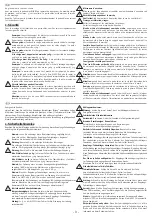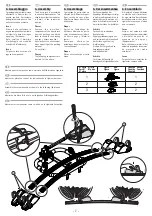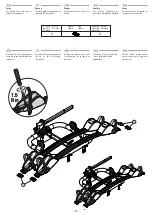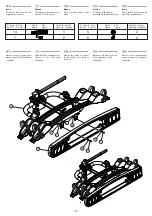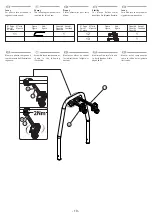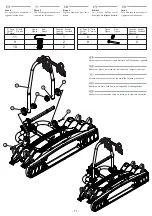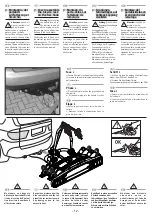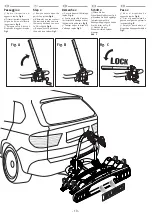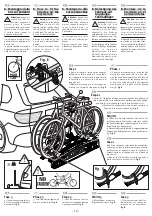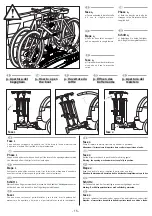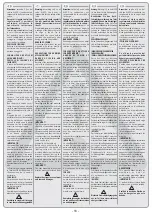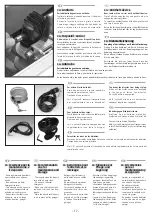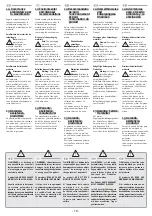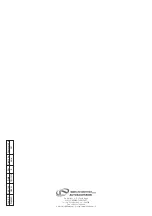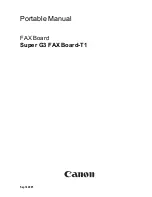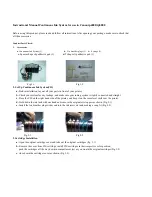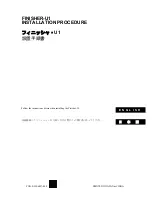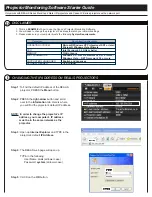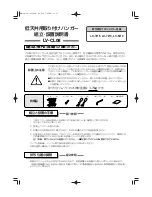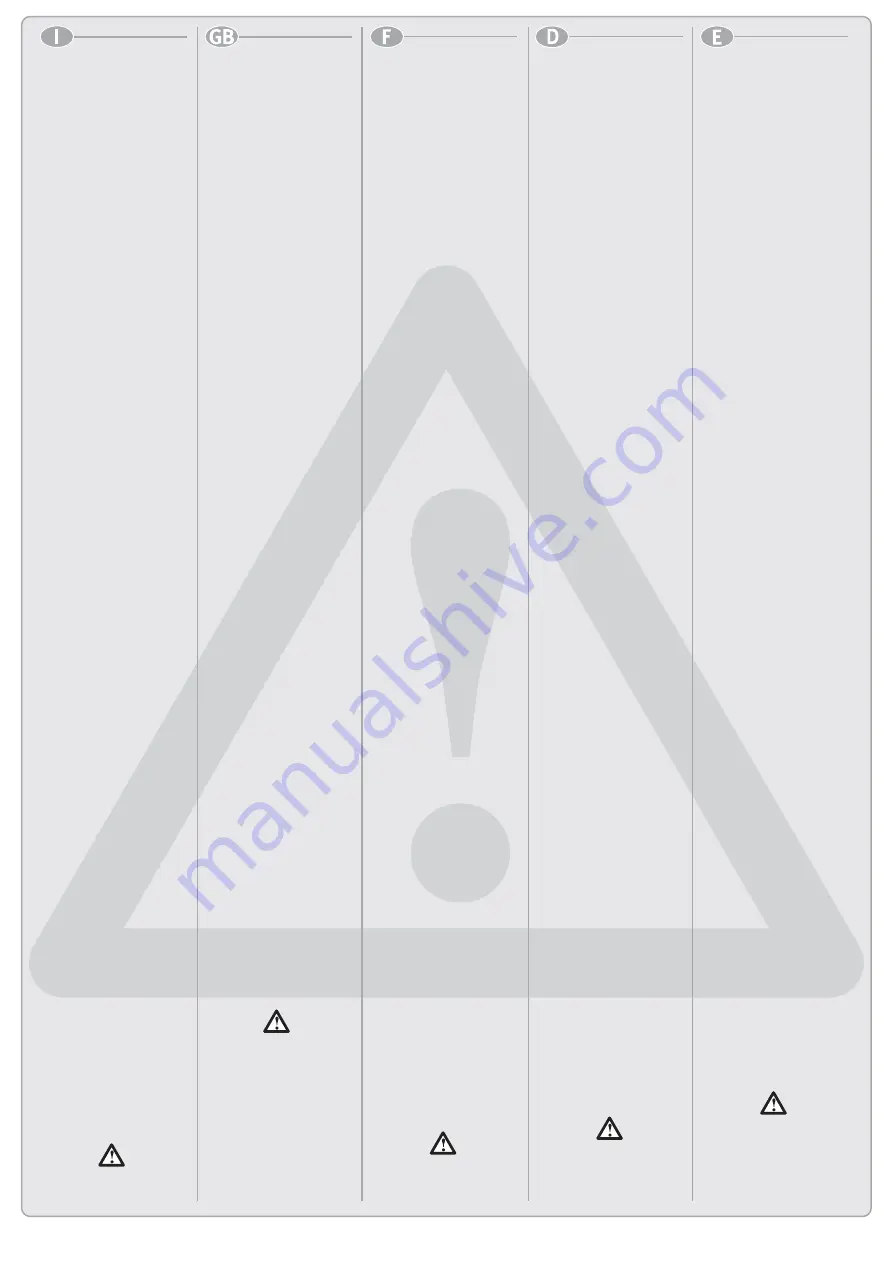
- 16 -
Warning:
according to § 22 of
code StVZO, the driver is
responsible for the safety of the
load.
During the trip check regularly
the rear mounted bike carrier
through the rear view mirror of
the car.
Stop immediately in case in which
a change of the bike carrier or of
its cargo is found. Try to
understand the cause and to
continue the travel only after
having resolved the problem.
DANGER OF LESION !
In the area of rotation of the rear
mounted bike carrier must be
neither people nor objects
SUGGESTIONS FOR A DRIVING
STYLE MODIFIED!
DA N G E R O F LE S I O N A N D
ACCIDENT !
Because of the rear mounted bike
carrier that sticks out from the
car and in cargo presence, it can
take place a greater tendency to
over-steering, a various behavior
in case of cross-wind and a
various behavior in case of
braking, particularly on a bend.
A loss of control of the car could
be taken place causing an
accident that could damage you
or other persons.
Guide with caution and adapt the
speed to the type of road.
Do not cover – in any case – the
cargo with a plastic or similar
material, as these could influence
on the state of guide.
Travelling with the rear mounted
bike carrier fixed to the car make
the possible to move the cargo
of the trunk towards the front
part thus to prevent an excessive
rear loading.
Control the shocks-absorber
regularly.
IMPORTANT!
The driver must make sure that
the cable of connection between
the rear mounted bike carrier and
the motor vehicle does not touch
the ground and that not there
are objects that can be entangled
so as to avoid that the connection
cable can be torn.
Eventually fix the cable up.
Before every travel verify the
functionality of the device of
lighting system of the rear
mounted bike carrier. In order to
prevent damages during the
maneuvers do not leave the rear
mounted bike carrier fixed to the
motor vehicle more of the
necessary.
IMPORTANT!
The rear mounted bike carrier
must be mounted to closed door.
Replace the straps in case of wear
and tear and damages.
Attention:
selon le § 22 du code
StVZO le conducteur est
responsable de la sécurité de
la charge.
Pendant le voyage contrôler
régulièrement le porte vélo arrière
par le rétroviseur de la voiture.
S’arrêter immédiatement si on
relève un changement du porte
vélo ou de son chargement.
Déterminer la cause et reprendre
le voyage seulement après avoir
résolu le problème.
DANGER DE LÉSION !
Aucune personne et aucun objet
doit se trouver dans la zone de
rotation du porte vélo arrière.
CONSEILS POUR UN STYLE DE
CONDUITE MODIFIÉ !
D A N G E R D E L É S I O N E T
D’ACCIDENT !
À cause du porte vélo arrière qui
sort de la voiture et en particulier
en présence du chargement, peut
être qui on relève une tendance
supérieure à survirer, un
comportement différent en cas
de vent transversal, en cas de
freinage et en particulier dans les
virages.
Peut être qui on perd le contrôle
de la voiture, ce qui pourrait
c a u s e r u n a c c i d e n t e t
endommager Vous ou des autres
personnes.
Conduire avec prudence et
adapter la vélocité aux conditions
de la route.
En a u c u n c a s c o u v r i r l e
chargement avec une plastique
ou matériaux similaires, car ils
pourraient influer fortement sur
le style de conduite.
Quand le porte vélo arrière est
monté sur la voiture on doit faire
le possible pour déplacer le
chargement du coffre vers la parte
antérieure de façon à prévenir un
excessif chargement postérieur.
Condition fondamentale pour
compromettre le moins possible
le style de conduite est un bon
état des amortisseurs de la
voiture.
Faire contrôler régulièrement les
amortisseurs.
IMPORTANT !
Le chauffeur doit s’assurer que
le cave de connexion entre le
porte velo arrière et la voiture ne
touche pas le sol et qu’il n’y a
aucun objet qui pourrait se
prendre, de façon à éviter que le
cave de connexion se déchire.
Éventuellement fixer le cave dans
la parte supérieure.
Avant chaque voyage vérifier la
fonctionnalité du dispositif
d’illumination du porte vélo
arrière.
CONSEIL !
Po u r p r é v e n i r d o m m a g e s
éventuels pendant les manouvres
ne pas lasser le porte vélo arrière
fixé sur la voiture plus du temps
nécessaire.
IMPORTANT !
Le porte vélo arrière doit être
monté avec l’hayon fermé.
Remplacer les sangles de fixation
en cas qu’elles sont consommées
ou endommagées
Achtung:
Achtung: lt. § 22 der StVZO
ist der Fahrer für die Sicherung der
Ladung verantwortlich.
Beobachten Sie den Heck-
Fahrradträger während der Fahrt
regelmäßig durch den Rückspiegel
Ihres Fahrzeuges.
Halten Sie sofort
bei einer erkennbarer Veränderung
des Heck-Fahrradträger oder seiner
Ladung an. Suchen Sie nach der
Ursache und setzen Sie Ihre Fahrt
erst nach Behebung des Problem
fort.
VERLETZUNGSGEFAHR!!
Keine Person bzw. Gegenstand darf
sich im Rotationsbereich des Heck-
Fahrradträgers befinden.
!HINWEISE ZUM VERÄNDERTEN
FAHRVERHALTEN!
!UNFALL- UND VERLETZUNGSGEFAHR!
Durch den über das Fahrzeug
hinausragenden Heck-Fahrradträger
kann besonders bei Beladung eine
stärkere Tendenz zum Übersteuern,
v e r ä d e r t e s S e i t e n w i n d a n -
sprechverhalten und ein verändertes
Bremsverhalten, besonders bei
Kurvenfahrt, auftreten. Sie können
die Kontrolle über lhr Fahrzeug
verlieren und so einen Unfall
verursachen, bei dem Sie oder andere
Personen verletzt werden können.
Fahren Sie vorsichtig und passen Sie
Ihre Geschwindigkeit stets an die
Straßenverhältnisse an.
Decken Sie auf keinen Fall die Ladung
mit einer Folie oder sonstigen
Materialien ab, da hierdurch das
Fahrverhalten stark beeinflusst wird.
Schwere Ladung im Koffer-/Landeraum
sollte beim Fahrbetried mit dem Heck-
Farradträger möglichst weit vorn
verstaut werden, um einer
übermäßigen Hecklastigkeit
vorzubeugen. Voraussetzung für eine
geringe Beeinträchtigung des
Fahrverhaltens ist der verkehrssichere
Zustand der Fahrzeug-Stoßdämpfer.
Stoßdämpfer regel mäßig prüfen
lassen.
Lassen Sie die Stoßdämpfer
regelmäßig prüfen.
!WICHTIG!
Der Fahrer muss sicherstellen, dass
das Verbindungskabel zwischen
Fahrzeung und Heck-Fahrradträger
nicht über den Boden schleift bzw.
dass sich keine Gegenstände darin
verfangen können damit ein
Durchscheuern bzw. Abreißen des
Verbindungskabels vermieden wird.
G e g e b e n e n f a l l s m u s s d a s
Verbindungskabel hochgebunden
werden.
11. Kontrollieren Sie vor jedem
Fahrantritt die Funktion der
Beleuchtungseinrichtung Ihres Heck-
Fahrradträgers.
HINWEIS
Zum Schutz vor Rangierschäden sollte
der Heck-Fahrradträger nicht länger
als notwendig am Fahrzeug
verbleiben.
!WICHTIG!
Der Heck-Fahrradträger muss bei
geschlossenem Kofferraumdeckel bzw.
geschlossener Heckklappe montiert
werden.
Wechseln Sie die Befestigungsgurte
aus, im Fall dass sie verschlissen
oder geschadet sind.
Attenzione:
secondo il § 22 del
codice StVZO il conducente è
responsabile della sicurezza del
carico.
Durante il viaggio controllare
regolarmente il por tabici
p o s t e r i o r e a t t r a v e r s o l o
s p e c c h i e t t o r e t r o v i s o r e
dell’autovettura.
Fermarsi immediatamente nel caso
in cui si rilevi un cambiamento
del portabici oppure del suo
carico. Individuarne la causa e
proseguire il viaggio solo dopo
aver risolto il problema.
PERICOLO DI LESIONE!
Nell’area di rotazione del portabici
posteriore non devono trovarsi
persone nè oggetti.
CONSIGLI PER UNO STILE DI
GUIDA MODIFICATO!
PERICOLO DI LESIONE E DI
INCIDENTE!
A causa del portabici posteriore
che sporge dall’autovettura ed in
particolare in presenza di carico,
può verificarsi una maggiore
tendenza a sovrasterzare, un
diverso comportamento in caso
di vento trasversale e un diverso
comportamento in caso di frenata,
in particolar modo in curva.
Potrebbe verificarsi una perdita
di controllo dell’autovettura così
da causare un incidente che
potrebbe danneggiare Lei od altre
persone.
Guidare con prudenza ed
adeguare la velocità al tipo di
strada.
Non ricoprire in nessun caso il
carico con una plastica o materiali
simili, in quanto questi potrebbero
influire fortemente sullo stile di
guida.
Viaggiando con il portabici
posteriore fissato all’autovettura
fare il possibile per spostare il
carico del baule verso la parte
anteriore così da prevenire un
eccessivo carico posteriore.
Presupposto per compromettere
il meno possibile lo stile di guida
è u n b u o n o s t a t o d e g l i
ammortizzatori dell’autovettura.
Far controllare regolarmente gli
ammortizzatori.
IMPORTANTE!
L’automobilista deve assicurarsi
che il cavo di collegamento tra il
portabici posteriore e l’autovettura
non tocchi il suolo e che non ci
siano oggetti che si possano
impigliare in modo da evitare che
il cavo di collegamento sfreghi e
quindi si possa strappare.
Eventualmente fissare il cavo in
alto.
11. Prima di ogni viaggio verificare
la funzionalità del dispositivo di
illuminazione del portabici
posteriore.
CONSIGLIO
Per prevenire danni durante le
manovre non lasciare il portabici
posteriore fissato all’autovettura
più del necessario.
IMPORTANTE!
Il portabici posteriore deve essere
montato a portellone chiuso.
Sostituire le cinghie di fissaggio
in caso di usura o danneggiamenti.
Atención:
según el § 22 del
código StVZO el conductor es
responsable de la seguridad
de la carga.
Durante el viaje controlar
regularmente el portabicicletas
trasero con el espejo retrovisor
del vehículo.
Pararse inmediatamente si se
observase algún problema en
dicho portabicicletas o en la carga.
Individualizar la causa y sólo
tras haber resuelto el problema
continuar el viaje.
¡PELIGRO DE LESIONES!
En el área de rotación del
portabicicletas trasero no debe
haber ni personas ni objetos.
En el área de rotación del
portabicicletas trasero no debe
haber ni personas ni objetos.
¡PELIGRO DE LESIONES Y DE
ACCIDENTES!
Debido a que el portabicicletas
trasero sobresale del vehículo,
en particular cuando está cargado,
habría una mayor tendencia a
sobrevirar, especialmente en caso
de viento transversal o de frenado,
particularmente en las curvas.
Por lo tanto, podría verificarse
una pérdida en el control del
vehículo lo que provocaría
accidentes con los consiguientes
daños para UD. u otras personas.
Importante: conducir con
prudencia y adecuar la velocidad
al tipo de carretera.
No cubrir en ningún caso la carga
con plástico o materiales similares
p o r q u e p o d r í a n i n f l u i r
notablemente en la conducción
del vehículo.
Viajando con el portabicicletas
trasero fijado al vehículo,
desplazar lo más posible la carga
del maletero hacia la parte
delantera para evitar que la carga
trasera sea excesiva.
Esto ayudará a no comprometer
la conducción como así también,
a evitar el desgaste excesivo de
los amortiguadores.
Hacer controlar regularmente los
mismos.
¡IMPORTANTE!
El automovilista debe cerciorarse
que el cable de conexión entre
el portabicicletas trasero y el
vehículo no toque el suelo y que
no haya objetos que se pudiesen
enganchar con dicho cable pues
frotándose podría romperse.
Eventualmente fijarlo a lo alto.
Antes de cada viaje, controlar la
correcta funcionalidad del
dispositivo de iluminación del
portabicicletas trasero.
ADVERTENCIA
Para prevenir daños durante las
m a n i o b r a s , n o d e j a r e l
portabicicletas trasero más tiempo
del necesario fijado al vehículo.
¡IMPORTANTE!
El portabicicletas trasero debe
montarse con el portón cerrado.
Sustituir la cincha de fijación en
caso de desgaste o que este
dañada.


